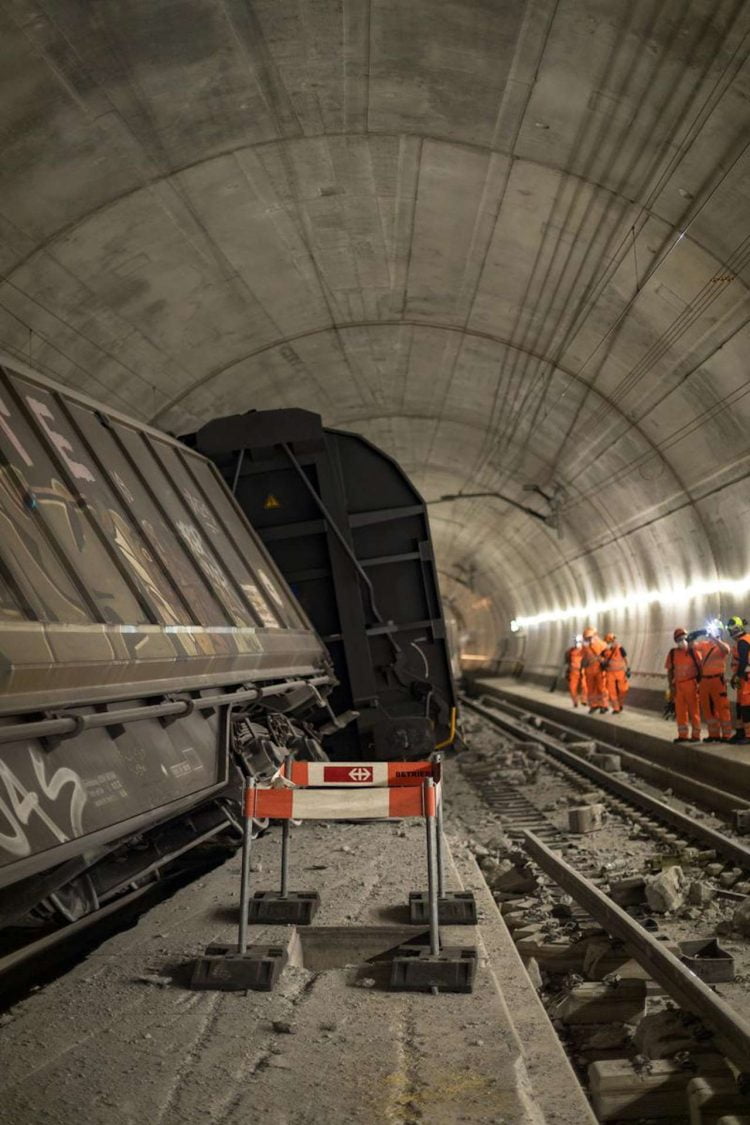The Swiss Safety Investigation Board (STSB) and the Public Prosecutor's Office of the Canton of Ticino are investigating the cause of a derailment on 17 August in the west tube of the Gotthard Base Tunnel.
The accident involved a train of 30 freight wagons that had been assembled in Italy, and had been checked on arrival in Chiasso, where SBB Cargo took over the train, and re-assembled the wagons into a new train. Nothing was found to be wrong during the checks. Although the accident site has been cleared, extensive clean-up work is required and 16 derailed and damaged wagons are still in the tunnel.

As the train travelled north through southern Ticino, the driver of an oncoming train reported smoke coming from the train.
An inspection in Bellinzona found a stuck brake on a freight wagon, which was released, although this was not the wagon that was thought to be the first to derail. The train was released for further travel, and passed through automatic control devices between Bellinzona and the tunnel, none of which triggered an alarm.
The derailment damaged about 8 kilometres of track and 20,000 concrete sleepers, all of which need to be replaced. The track bed is severely damaged and it will be several months before all the damage is repaired. SBB plans that both bores of the tunnel will open for a limited rail service at the beginning of next year. SBB is endeavouring to open the undamaged east tube for freight traffic as soon as possible.
From this Wednesday, 23 August, freight traffic will be able to use the undamaged east tunnel, but they will be diverted via the Gotthard panorama route and via the L tschberg-Simplon axis so that all goods can be transported.
Since the closure of the tunnel, passenger trains have been running on the panorama route and will continue to do so until further notice. Travel time for domestic traffic is taking up to 60 minutes longer and between 60 and 120 minutes for international traffic, with a change of trains in Chiasso. Only trains to and from Genoa and Venice can run directly.
SBB and the Federal Office of Transport are considering whether some passenger trains could use the east tube in single-track operation. The problem is that if there is an emergency, passengers would need to be evacuated via the west tunnel tube, which would only be possible to a limited extent because of the repair work in that tube.
Although a large part of SBB s internal freight traffic could travel via the panoramic route, only a few transit and import/export trains can be travel via that route since the rolling stock on those trains would be out of gauge.
SBB is examining whether the seating capacity on the Gotthard panorama route can be increased and whether additional direct international connections can be offered.
Speaking about the effects of the accident, SBB CEO Vincent Ducrot said: “The Gotthard Base Tunnel is one of the safest in the world. The fact that such an accident could still happen hits us very hard. Fortunately, there were no casualties, but there was a lot of property damage.
SBB is aware that the effects of the accident would cause great inconvenience to passengers and freight customers.
“We would like to apologize for this and ask for your understanding. The teams deployed are doing everything in their power to ensure that safe rail traffic through the Gotthard Base Tunnel is possible again as quickly as possible.”